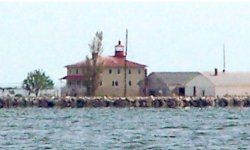greatgrandma
Silver member
- Joined
- 31 January 2025
- Posts
- 615
- Likes
- 2,556
- Name
- Rosalie
The original Piney Point Lighthouse Museum was flooded and closed by Hurricane Isabel in 2003. The building they are now using used to be a garage, and they were setting it up as a museum when we visited during the Annual Piney Point Days in May 2005. The museum was on on-going operation and was expected to be finished in 2008. It includes exhibits on the construction and operation of the Lighthouse.

On the grounds of the lighthouse is what is called the Potomac River Maritime Exhibit which houses the collection of four historic wooden vessels including a 67-foot skipjack (Joy Parks), an 84-foot bugeye, (Dorothy A. Parsons), a log canoe, and Potomac River dory boat.

The buoy in the Potomac where the U-1105 was sunk can't be seen from Piney Point, and is hard to find out in the river.

In the Museum is the exhibit on this German submarine, the Black Panther. It was a revolutionary feature in military weaponry because it was covered with a synthetic rubber coating making it “invisible” to the sonar of the day and creating one of the first stealth weapons.
The U-1105 Black Panther patrolled off the shore of Scotland. When the war was over, it was ordered to an Allied base in northern Scotland where it surrendered. The British later turned the submarine over to the United States Navy for study and experimentation in the U.S.
After preliminary testing the U-1105 was fatally damaged on September 19, 1949 and was sunk in 90 feet of water in the Potomac River at Piney Point by a Navy Explosive Ordnance Disposal team.
In June of 1985, the U-1105 was 'rediscovered' by a team of sports divers from Virginia, and after some archeological exploration, the U-1105 was designated as Maryland’s first Historic Shipwreck Dive Preserve and a National Historic Landmark. There are recreational diving opportunities for experienced divers. The U-1105 is a United States Naval ship and is protected by federal law.
On the grounds of the lighthouse is what is called the Potomac River Maritime Exhibit which houses the collection of four historic wooden vessels including a 67-foot skipjack (Joy Parks), an 84-foot bugeye, (Dorothy A. Parsons), a log canoe, and Potomac River dory boat.
The buoy in the Potomac where the U-1105 was sunk can't be seen from Piney Point, and is hard to find out in the river.
In the Museum is the exhibit on this German submarine, the Black Panther. It was a revolutionary feature in military weaponry because it was covered with a synthetic rubber coating making it “invisible” to the sonar of the day and creating one of the first stealth weapons.
The U-1105 Black Panther patrolled off the shore of Scotland. When the war was over, it was ordered to an Allied base in northern Scotland where it surrendered. The British later turned the submarine over to the United States Navy for study and experimentation in the U.S.
After preliminary testing the U-1105 was fatally damaged on September 19, 1949 and was sunk in 90 feet of water in the Potomac River at Piney Point by a Navy Explosive Ordnance Disposal team.
In June of 1985, the U-1105 was 'rediscovered' by a team of sports divers from Virginia, and after some archeological exploration, the U-1105 was designated as Maryland’s first Historic Shipwreck Dive Preserve and a National Historic Landmark. There are recreational diving opportunities for experienced divers. The U-1105 is a United States Naval ship and is protected by federal law.
Last edited:


